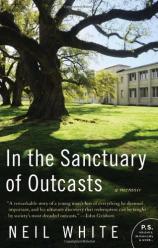Reading Group Guide
Discussion Questions
In the Sanctuary of Outcasts: A Memoir

1. Before you read In the Sanctuary of Outcasts, what did you think of when you heard the word "leper"? Did the book change your impressions?
2. When he was in the cafeteria, White would eavesdrop on the patients. He heard them call themselves "secret people." Why did they call themselves this? Did the name fit them?
3. From the time he was a young boy, White’s mother told him "you were put here to do great things. Don’t ever forget that." How did his mother’s attitude shape the man White was both before and after Carville?
4. White began his publishing career fighting for underdogs and the disadvantaged. What happened to those initial hopes? How can someone else escape the "success" trap that ensnared White and so many others?
5. "For as long as my children could remember, I had ignored fences and boundaries and rules. Nothing much had prevented me from getting what I wanted, and I made my children know it," White admits. How did this attitude land him in Carville? Do you see a correlation between White’s attitude and that of our wider society? How did the two reinforce each other? How did White eventually break free from this kind of thinking?
6. White came into contact with a variety of diverse characters during his year Carville, including Ella, Link, Doc, Jimmy Hoffa’s lawyer, Frank Ragano, Jimmy Harris, Steve Read. Talk about some of these people. What role did they play in White’s life while he was there? What did he learn from each of them?
7. White looked forward to seeing another leprosy patient, Sister Teresa Pazosas. Though the disease had ravaged her nose and fingers, "just being in her presence made me feel light and peaceful," White writes. "I didn’t fully understand why she had that effect on me, but I was beginning to feel certain about one thing. Carville was a sacred space." What made Carville a sacred place? Why was White able to see what many of the other inmates could not?
8. Why was White so drawn to Ella? What was the importance of the Coke bottle story?
9. How did someone like White who’d "spent my life surrounding myself with beautiful people," find such solace among the disfigured at Carville?
10. What lessons did prison teach White? There were a number of turning points in his transformation. Map the arc of events that led to his metamorphosis.
11. How did White’s view of his father change after he was at Carville?
12. While in high school, Neil White took a hard stand on the treatment of inmates. "When I was debating the merits of drug testing on prisoners, I never dreamed that I might someday be one." Why does experience tend to change our opinions or open our minds? Why aren’t many people able to empathize with others until they have been in their place, as White discovered in prison?
13. Before he arrived at the prison, White writes, "I had no idea of the absurdity, complexity, tragedy, and magic that was Carville." Explain how each fits this place, using examples from the memoir.
14. How did George Plimpton inspire White’s ambition to chronicle his time at Carville?
15. White tried to help the leprosy patients "rebrand" themselves. What suggestions might you have to help them change public perception?
In the Sanctuary of Outcasts: A Memoir
- Publication Date: June 1, 2010
- Paperback: 352 pages
- Publisher: William Morrow Paperbacks
- ISBN-10: 0061351636
- ISBN-13: 9780061351631







